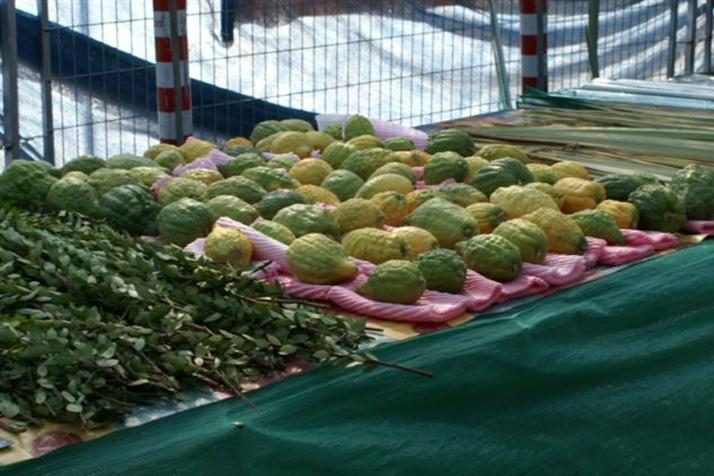At face value, the mitzvah of “Taking the Four Species” begs explanation. On the one hand, Halacha stipulates that once a person has lifted the Species (for the sake of performing the mitzvah), he has fulfilled his obligation (Sukkah 42a). On the other hand, after lifting the Species, one should wave them right away, as well as later on during Hallel. (Orach Chaim 651:8.) What is the function of waving the Species? Why are they waved in particular during Hallel?
 The Talmud (Sukkah 37b) addresses the symbolism of waving the Species. Rabbi Yochanan explained that, “One moves (the Species) back and forth for the sake of Him to Whom the four winds belong; one lifts and lowers (them) for the sake of Him to Whom are the heavens and the earth.” Others quote Rabbi Chama bar Ukva in the name of Rabbi Yose bar Rabbi Chanina as explaining that, “One brings (the Species in supplication) back and forth to prevent bad winds; one lifts and lowers (them in supplication) to prevent bad precipitation.” (See Rashi ibid.)
The Talmud (Sukkah 37b) addresses the symbolism of waving the Species. Rabbi Yochanan explained that, “One moves (the Species) back and forth for the sake of Him to Whom the four winds belong; one lifts and lowers (them) for the sake of Him to Whom are the heavens and the earth.” Others quote Rabbi Chama bar Ukva in the name of Rabbi Yose bar Rabbi Chanina as explaining that, “One brings (the Species in supplication) back and forth to prevent bad winds; one lifts and lowers (them in supplication) to prevent bad precipitation.” (See Rashi ibid.)
Although the Talmud’s elaboration addresses the message conveyed by waving the Species, it does not indicate the relationship between Hallel and the Species. Furthermore, it should be noted that waving the Species is not merely a symbolic rite. Rather, the waving is an integral component of the mitzvah of taking the Species, to the extent that one who failed to recite the berachah before taking the Species may still recite it prior to waving them (Mishnah Berurah 651:26), as the waving procedure is an extension of the mitzvah of taking the Species. Why is waving the Species so important from an halachic perspective? Again, why is it done during Hallel?
As noted in the dvar Torah, “Why is Sukkos Different”, Sukkos gives the Jew the opportunity to enter the inner sanctums of kedushah (the Sukkah, representative of the Beis Ha-Mikdash) after having been spiritually cleansed on Yom Kippur. On Sukkos, we are privileged to spend a week in the realm of the Shechinah, replicative of the experience which our ancestors had in the Midbar (Desert). For this reason, many communities which do not normally recite Kabbalistic prayers do so on Sukkos, as on Sukkos we are all “insiders”, dwelling in Hashem’s sanctuary and thus more privy to the internal spheres of spirituality.
This is where the role of the Four Species fits in. The Species are all features of inanimate nature. Inherently, they have no spiritual value. However, on Sukkos, the theme of living under Hashgachah (Divine Providence) is applied to its fullest. Not only do we enter the protective veil of the Sukkah; we also proclaim that the entire universe – even the seemingly stoic and disinterested features of nature – are precisely manipulated by God for His purposes. In the Midbar, nature was utilized by Hashem in most stupefying ways to achieve His goals for His nation. We celebrate God’s miraculous protection of the Jewish nation on Sukkos, in which natural objects and forces were specifically geared to shield us. So, too, on a daily basis, all that occurs in our seemingly mundane world is part of Hashem’s scheme for the universe and is testimony to His Hashgacha. This outward recognition of Divine Providence is expressed on Sukkos by the Four Species.
Thus, the Species are waved during Hallel when we thank Hashem for His goodness [the verses of “Hodu…”] and when we beseech Him [“Ana Hashem…”], as we affirm God’s extensive Hashgacha as epitomized on Sukkos, such that the entire natural order is manipulated by Hashem for His purposes and is therefore testimony of praise to Him. So, too, is waving the Species essential to the mitzvah of taking them, as waving the Species symbolizes the themes expressed by Rabbi Yochanan or Rabbi Yosi bar Chanina; these themes are manifestations of God’s universal Hashgacha, which is at the crux of the message of Sukkos and is therefore – by definition – integral to its mitzvos.
In light of the concept that the Four Species represent God’s external Hashgachah, in which nature and the universe as a whole are subservient and function to fulfill the Divine plan, we can understand the Midrashic symbolism of the Species. Chazal (our Sages) relate that the Species signify the components of a person’s body which serve God or that the Species are reflective of different types of Jews, all of whom must be bound together to do God’s will. The underlying theme of both sets of symbols is that the Species express performance of God’s mission, such that we realize that even bare nature is utilized as part of the Divine system and Providence.
This also explains the Kabbalistic practice of taking the Species each morning in the Sukkah, even though it may be halachically preferable to take the Species right before Hallel instead. By taking the Species in the Sukkah, one merges the inner Hashgacha of the Sukkah, which consists of God enabling Man to enter and dwell in the Shadow of the Divine, with God’s outward Hashgacha in the universe as a whole, where God’s Hand in immanent and all-involved, working through nature and lifeless forms to accomplish the Divine mission.
May we soon merit to enter the permanent Sukkah in Yerushalayim and experience God’s Hashgacha on all levels.
